Ford Anglia 105E
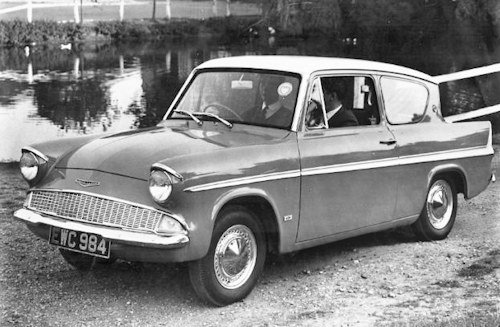 |
|
|
Production |
1959–67 1,004,737 units |
|
Assembly |
United Kingdom Australia |
|
Body style |
2-door saloon 3-door estate car 2-door panel van |
|
Engine |
1.0-1.2l |
|
Wheelbase |
91 in (2311 mm) |
|
Length |
154 in (3,912 mm) |
|
Width |
56 in (1422 mm) |
|
Height |
56 in (1422 mm) |
|
Curb weight |
1624 lb (737 kg) (saloon) |
The Ford Anglia 105E (also: New Anglia ) is a small passenger car of the Ford of Britain from 1959 to 1967
History
built as a two-door notchback sedan and from 1961 as the three-door station wagon and a van. A more powerful version was called the Anglia Super 123E . A striking feature of the sedan is the roof overhanging at the rear. Italian and British bodyworks produced special bodies with New Anglia technology.
From 1953, Ford of Britain offered the 100E series with two doors as the Anglia and the Prefect with four doors in the compact class. The 100E series automobiles were the first Ford models produced in the United Kingdom to have a self-supporting body. In 1956, the old 100E Anglia was replaced by the new 100E Popular, and the four-door Prefect bodyshell was replaced by the new Ford Prefect (107E), which had all of the 105E running gear, including the engine and brakes, while the 100E Escort and Squire remained intact. The 105E Anglia estate took over the Escort and Squire estates in 1961. Both cars are still popular among hot rodders, because to the interchangeability of parts and the car's ability to be tuned.
The 100E delivery van also gave way to a new vehicle based on the 105E. Identical to the Anglia 105E back to the B post, the rest of the vehicle was entirely new.Ford's newly formed planning department in Dagenham began considering a successor to the 100E series. Their development fell into the overall responsibility of the engineer Frederick Leslie "Fred" Hart (1914–2008) . With a view to the planned restructuring of the model range, the decision was made early on to offer the 100E successor from 1959 exclusively with two doors.
The New Anglia appeared in October 1959. It was offered alongside the previous Anglia of the 100E series, which was now given the model name Ford Popular and continued to be built until 1962 with slightly modified technology but unchanged body. A four-door version of the New Anglia did not exist. Instead, the previous Prefect 100E and the slightly larger Consul Mark II were initially continued to be produced before both found their successors in the four-door Consul Classic in 1961 . The Consul Classic was larger than the Anglia and in the lower middle class positioned so that with the discontinuation of the Popular in 1962, the Anglia assumed the role of the entry-level model at Ford. In October 1961, a station wagon version of the New Anglia and a van derived from it followed.
Presentation and production
The production of the series model began in Great Britain in June 1959, although the market launch of the New Anglia was not planned for autumn 1959. In this way, the Ford dealers should have the opportunity not only to show the new car, but also to sell existing examples directly. Initially, the New Anglia was created in Ford's ancestral factory in the London suburb of Dagenham; In March 1963, production was then relocated to the new Ford plant in Halewood near Liverpool , which was far more automated.Except in Great Britain was the New Anglia over the years also built in Belgium, Portugal, Australia, South Africa and Rhodesia.
The New Anglia debuted at the Earls Court Motor Show in October. At the same exhibition, Ford competitor BMC introduced the Mini and the Triumph Herald . Ford advertised the Anglia 105E in Earls Court and later in advertisements as “ The world's most exciting light car” . It was one of the outstanding exhibits at the exhibition. By the end of the ten-day motor show, Ford had received 101,000 orders for the New Anglia , two-thirds of which came from Ford's North American subsidiaries.
The Anglia 105E has been sold worldwide. Ford also offered it on almost all Western European markets, but not in the Federal Republic of Germany. In the first full calendar year after its introduction, the Anglia 105E was the most successful car on the British market: in 1960 Ford sold more than 200,000 copies of the model in Great Britain. The Anglia was also successful in other markets around the world. By November 1967 Ford had built a total of 954,426 saloons of the 105E and 123E series; In addition, there were 129,529 factory station wagons (Estates) .
The New Anglia was at times one of the cheapest British-made cars. Only the price of the Mini was a few pounds below that of the Anglia. While the British Motor Corporation made a loss of £ 5 on every Mini, Ford made a profit on the New Anglia, according to official statements. There is some talk of around £ 45 per car. some sources doubt the accuracy of this information.Price trends in the UK have fluctuated over the years. Ford managed to lower prices several times. In some cases, however, tax cuts also played a role.
Production of the New Anglia ended in 1967 . The Ford Escort took its place .
Engine and transmission
The New Anglia is powered by a four-cylinder engine with overhead valves . The engine is the first variant of the Kent series, newly introduced in 1959 , developed by Ford engineer Alan Worters. In the Anglia 105E it has a displacement of 997 cm³ (bore × stroke: 80.96 mm × 48.41 mm). The motor is therefore extremely short-stroke ( stroke ratio 0.6: 1). The compression ratio is 8.9: 1. In this form, the engine delivers a maximum of 39 bhp (29 kW; 39 PS) at a speed of 5000 per minute. The maximum torque of 53 ft · lb (72 N · m) is achieved at 2700 rpm.
PERFORMANCE: 1000cc
- Engine capacity: 60.98 cu in, 997.14 cu cm
- Fuel consumption: 35.3 m imp gal, 29.4 m
- Max speed: 80.8 mph, 130 km h
- Max power (SAE): 39 hp at 5000 rpm
- Max torque (SAE): 53 1b ft, 7.3 kgm at 2700 rpm
- Max number of engine rpm: 5600
- Specific power: 39.1 hp/l
- Power-weight ratio: 40.6 lb.hP, 18.4 kg/hp
- Acceleration: 0—50 mph (0 —80 km/h) 21.6 sec
The power is transmitted by a manual gearbox with center shift, for the first time at Ford of Britain with four gears. With the exception of the first gear, all gears are synchronized .
Chassis
The front wheels are individually suspended on MacPherson struts with wishbones and stabilizers . At the rear, the Anglia has a rigid axle on longitudinally asymmetrical leaf springs with lever shock absorbers . The nib has four leaves on the sedan and seven on the estate versions. In order to increase driving comfort, Ford chose longer leaf springs for the New Anglia than on the previous model. The recirculating ball steering system supplied by Burman and Sons . The brakes came from Girling. They correspond to those of the predecessor.
Body Construction
The New Anglia has a self-supporting body made of pressed steel sheets. The floor panel has cross-shaped reinforcements in the passenger area, which contribute to the high torsional rigidity of the body.
Design
The New Anglia was designed by Ford of Britain. It combines US and European elements. According to one source, the US Ford designer was Elwood Engel closely involved in the development of body shape.
For Ford of England, a manufacturer that had been emphatically conservative up to that point and often preferred simple solutions, the New Anglia was a politically significant car. It was the manufacturer's first car to be designed according to contemporary criteria, and it showed Ford that one could build economically successful cars with modern design features.
The original version of the New Anglia is designed as a two-door notchback sedan (saloon) . The shape remained almost unchanged until production was discontinued in 1967. Ford claimed to have conducted extensive wind tunnel tests on the body. In order to reduce air resistance, the bonnet between the headlights has been shaped to slope down. The front headlights have lid-like covers in the upper area.
Special design features of the New Anglia Saloon are the overhanging roof and the C-pillar , which is inclined forward in the lower area and whose angle corresponds approximately to that of the A-pillar. With this unusual shape, which is in contrast to the trapezoidal line that was emerging at the time, the Ford designers wanted to achieve the greatest possible headroom on the back seat. In addition, the view through the rear window remains unimpaired, even when it rains, because no raindrops stick to the inwardly inclined pane. Ford's US subsidiary Lincoln had already introduced a corresponding design in 1958 for the Continental Mark III .In these very expensive luxury vehicles, the rear window was electrically retractable (so-called breezeway window ). Corresponding designs were also found in the Mercury sedans . In the small British Anglia, on the other hand, the rear window is permanently mounted. In 1961, Ford of Britain took the form for the four-door Consul Classic sedan; In the same year Flaminio Bertoni at Citroën for the Ami 6 , which is almost the same size as the Anglia, and Reliant took it up for the three-wheeled microcar Regal 3/30 .At the rear end there are small tail fins with a combination of tall, narrow and round lights.
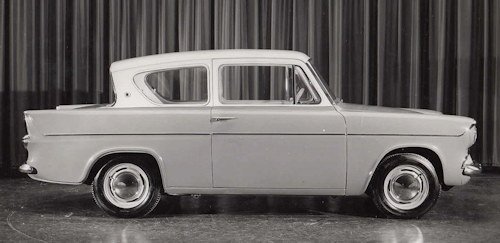
Versions
In addition to the basic model, a technically identical, but better equipped deluxe version was offered. Outwardly, both variants differ from each other primarily in the design of the front mask. In the basic version, the radiator opening is narrow and framed by painted metal sheets on the left and right. In the deluxe version, on the other hand, the radiator grille extends over the entire width of the car. The Anglia Deluxe also has more chrome decorations than the basic version. The additional equipment of the Deluxe includes a display for the engine temperature, hinged rear side windows, high-quality seat covers and leather upholstery available for an extra charge.
Dimensions, weights and performance
The New Anglia is 3912 mm long and weighs 737 kg in the basic version. It is around 6 cm longer than its predecessor, but 25 kg lighter. The top speed is 79 mph (127 km / h). Accelerating from 0 to 60 mph (96 km / h) takes 26 to 29 seconds, depending on the gear ratio of the rear axle.
Anglia Super 123E
In October 1962, Ford introduced the more powerful and better equipped Anglia Super 123E as the new top model.
The Anglia Super 123E has a 1.2 liter version of the Kent four-cylinder engine, which was designed for the Cortina mid-range sedan introduced in 1962 . The displacement was increased to 1198 cc by increasing the stroke to 58.17 mm. This increases the engine output to 48.5 bhp (36 kW; 49 PS). The top speed of this version is 84 mph (135 km / h). A fully synchronized four-speed gearbox takes over the power transmission as standard.
- PERFORMANCE: 1200cc Super
- Engine capacity: 73.10 cu in, 1,198 cu cm
- Fuel consumption:35.3 m/imp gal, 29.4 mlUS gal, 8 x 100 km
- Max speed: 84 mph, 135.2 km/h
- max power (SAE): 54 hp at 5,000 rpm
- max torque (SAE): 69 1b ft, 9.5 kg m at 2,700 rpm
- max number of engine rpm: 5,600
- specific power: 45.1 hp/l
- power-weight ratio: 30 lb/hp, 13.6 kg/hp
- acceleration: standing 1/4 mile 21.5 sec, 0— 50 mph (0— 80 km/h) 13.8 sec
Externally, the Anglia Super 123E differs from the Anglia 105E Deluxe through a special two-tone paint finish, in which the roof and the bead in the sides of the car are painted in a color that contrasts with the color of the other sheet metal parts. The equipment of the Super 123E surpasses the deluxe version of the Anglia 105E, the production of which has continued without restrictions. Carpets in the interior, a heater, electric windshield wipers and a cigarette lighter were standard equipment in the Super 123E.The Anglia Super 123E was £ 598 when it launched. It was £ 60 more expensive than the 105E Deluxe and £ 84 more than the basic 105E.
Equipment packages
From the end of 1962 to October 1964, an equipment package called the "1200 Package" was available for the 105E and 105E Deluxe. It comprised the 1.2-liter engine and the fully synchronized gearbox of the Super 123E, but not its higher-quality interior and the two-tone paintwork. The price of the "1200 Package" was £ 24. In autumn 1964 the “1200 Package” was discontinued. It was replaced by the “Super Package”, which was available for an additional £ 25 for the Anglia 105E Deluxe. It included the high-quality equipment of the Super 123E, but not its more powerful engine.
Factory Body combinations
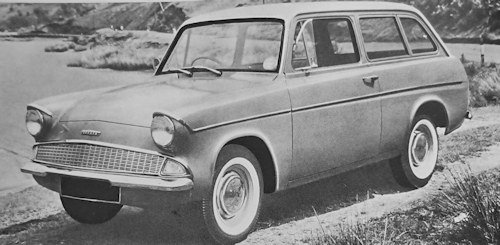
Anglia Estate
After the body builder Friary Motors had launched station wagons based on the Anglia sedan on the market in the spring of 1961 , Ford introduced the Anglia Estate at the British Motor Show in October 1961 , a station wagon that had nothing in common with the Friary alteration. The design of the factory estate was the work of the Canadian Roy Brown Jr. , who had designed the Edsel brand models for Ford a few years earlier .
The chassis of the Estate is almost entirely the same as that of the Anglia Saloon . The rear leaf springs, which consist of seven instead of four leaves on the station wagon, as well as the gear ratio have been revised. Stylistically, the station wagon corresponds to the saloon up to the side doors . The rear structure, on the other hand, is independent. Instead of the retracted roof section of the sedan, the Estate has a narrow C-pillar attached to the rear, the angle of inclination of which is opposite to that of the A-pillar. The side parts are glazed. The taillights are redesigned; The station wagon does not have tail fins. The one-piece tailgate is hinged at the top. The rear seat backrest can be folded down so that a flat loading area can be created up to the front seats.The estate was initially available only with the 1.0-liter four-cylinder engine; from 1962 the 1.2 liter engine of the Anglia Super 123E could also be ordered. Both the basic and the deluxe version were available.
Anglia Estate Combi
A special version is the Estate Combi , which was only built for export. Its body corresponds to the regular Estate , but instead of the rear side windows it has metal panels so that the cargo space cannot be seen from the outside. The Estate Combi was a link between the Estate family vehicle and the purely commercial vehicle Ford Thames / Anglia Van. The equipment level of the Estate Combi corresponds to the basic version of the Anglia.
Commercial Vehicle: Ford Thames 307E / 309E Anglia and Van
Parallel to the family model Estate , a version of the New Anglia was released in 1961, intended for purely commercial purposes . It was marketed until February 1965 under the model name Thames , which Ford used for commercial vehicles; from March 1965, however, Ford changed the model name to Anglia Van.
The Thames is technically the same as the Anglia Estate . Both engines offered in the Anglia were also available for the Thames. The 1.0-liter version with right-hand drive was sold as the Thames 307E and left-hand drive as the 308E, the variant with the 1.2-liter engine of the Anglia Super was called the Thames 309E or 310E. The front end of the Thames corresponds to the Anglia Estate . The roof is higher, however, and the rear structure is box-shaped. The windshield also has a steeper angle. The doors are newly designed. Your lower degree is different from that of the saloon and estate; it rises slightly rounded towards the rear. This independent design should enable the doors to be opened even when the car is parked close to a high curb. The rear side panels could be supplied with glazing or made of sheet metal, as required by the customer. The Thames was very simply furnished. There was only one driver's seat ex works. A passenger seat was available at an additional cost. The car could be adapted to different payloads. 250 kg (5 ctw ) and 350 kg (7 ctw) were possible. The loading volume is 2.1 m³.
Anglia variants independent manufacturer
Anglia Touring Saloon of Friary
Half a year before Ford brought the Anglia Estate onto the market, the small British coachbuilder Friary Motors from Basingstoke , Hampshire , presented its own station wagon version of the New Anglia . The three-door, known as the Touring Saloon , was actually a design by the established bodywork manufacturer Abbott of Farnham , who had been successfully producing station wagons of Ford sedans since 1955. Friary Motors was an Abbott subsidiary that made comparable conversions for sedans from Ford's competitor Vauxhalloffered. After the expiry of the Vauxhall contract, there was the opportunity to use the freed-up capacities at Friary for combi-builds in the small New Anglia . Abbott, however, continued to market station wagon versions of the large Ford sedans Zephyr and Zodiac .
The Touring Saloon of Friary significantly different from the half a year later introduced the Ford plant combination. Unlike Ford, Friary kept the upper roof section of the New Anglia sedan unchanged; the rear fins also correspond to the series sedan. The C-pillar on the Touring Saloon has been redesigned; with it, the roof structure now forms a trapezoidal shape. The rear side windows differ from those of the sedan. The one-piece tailgate is hinged at the top. The conversion cost £ 89, roughly one sixth the price of a new standard Aglia Saloon (£ 606 in July 1961).
Anglia Sports Saloon Abbott
In the spring of 1962 Abbott took over the conversion of the New Anglia into a three-door in Wrecclesham and then marketed the car as the Anglia Sports Saloon . The friary construction was largely adopted, but Abbott did without the newly made rear side windows, which, according to a source, had significant sealing problems. Instead, the regular side windows of the Anglia Saloon were installed, which made it necessary to adapt the rear side panels. Abbott's conversion was slightly cheaper than the friary version; it was only £ 75. The Sports Saloon was almost as expensive as a Ford factory station wagon.
Pick-up of Martin Walter
In 1961, the body builder Kenex Coachwork from Dover developed a two-seater pick-up version of the Ford Thames. The conversion costs were calculated at £ 45. Before this variant to go into series, Kenex was from the car dealer Martin Walter of Folkestone taken, which began to manufacture the pick up after a delay of nearly three years in 1964 as standard.
Anglia Torino from OSI
The Anglia Torino is a sedan made in Italy with Anglia technology and an independent body. Their development goes back to Ford Italia. The Rome- based Ford subsidiary in Italy sold the imported Anglia 105E in the early 1960s, initially with some success. The British car was soon felt to be out of fashion, mainly because of its unusual roof design, and sales fell significantly. As early as 1963, Ford Italia saw the need for a stylistic revision, which Ford of Britain did not want to make. The Italian management then gave the Turin designer Giovanni Michelotticommissioned a new body for the Anglia chassis. Michelotti designed a straight notchback sedan with a trapezoidal roof structure, thin vehicle pillars and a high trunk. Ford Italia had this design produced in series at Officine Stampaggi Industriali (OSI) in Turin from 1965 and offered it in Italy as Anglia Torino from April 1965 alongside the British Anglias. The Anglia Torino was optionally available with the 1.0-liter engine or with the 1.2-liter four-cylinder; The latter was delivered as an S version with a double carburetor from Weber (Weber 28 / 36DCD).
Sales of the Anglia Torino fell short of expectations. By 1967, Ford had only sold 10,007 Anglia Torinos in Italy. According to some sources, the poor build quality of the OSI body damaged the car's reputation. The attempt to sell the model in other European markets had limited success. In the end, the Anglia Torino only came onto the market in the Benelux countries; the cars sold there were assembled by Ford's Belgian branch.
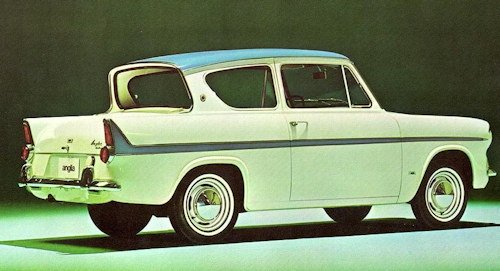
References in popular media and celebrity connections
- On BBC television the popular Z-Cars serial mimicked the real life police forces' adoption of small patrol cars, known as Panda Cars due to their duck egg blue paintwork with a broad vertical white stripe running right over the doors and roof. Ford supplied 105E Anglias to appear alongside the Zephyrs.
- On the ITV programme Heartbeat, Ford Anglias were popularly used as police cars.
- On his 1980s TV-am series "Rat on the Road" and later shows, puppet character Roland Rat and his friends' "RatMobile" was a 1950s Ford Anglia painted bright pink.
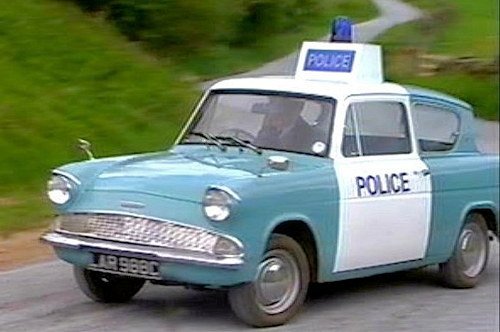
- A light blue Anglia 105E with a white painted roof plays a role in Harry Potter and the Chamber of Secrets. With their father's flying Anglia, Fred, George and Ron Weasley bring Harry Potter out of his relatives' house at the beginning of the story ; later Ron and Harry fly from London to Hogwarts in an invisible car . As the story progresses, the Anglia saves Harry and Ron from the Forbidden Forest . He is featured on the original UK cover of the novel.
The 2002 feature film of the same name contains scenes with a flying Anglia (license number 7990 TD). During the shooting, the producers used an authentic Anglia Deluxe built in 1962 or 1966 . For the special effects, the car was attached to a rotating crane so that it could be moved in any direction. 2005, the non-roadworthy car used in the film production was stolen from the premises of the then insolvent production company South West Film Studios in St Agnes , Cornwall . The theft generated strong media coverage in the UK. The car was later found. It is believed that the thieves were unable to sell it because of the extensive coverage.
- The character of Vyvyan in the BBC comedy The Young Ones owned a yellow Ford Anglia with flames painted along the sides.
Technical
-
Ford Anglia 105E Technical details and specifications (1959-1968)
ENGINE:1000 cc
location front
4 stroke; cylinders: 4, vertical, in line;
bore and stroke 3.18 x 1.90 in, 80.8 x 48.3 mm
engine capacity: 60.98 cu in, 997.14 cu cm
compression ratio: 8.9:1 (option) 7.5:1
cylinder block: cast iron
cylinder head: cast iron
crankshaft bearings: 3
valves: 2 per cylinder, overhead, in line, with push-rods and rockers
camshaft:1, side
lubrication: rotary or vane-type pump, full flow filtercarburation: 1 Solex 30 P.S.E.I. downdraft single barrel carburettor
fuel feed: mechanical pump
cooling system: waterENGINE: 1200cc Super
front, 4 stroke
cylinders: 4, vertical, in line
bore and stroke: 3.18 x 2.29 in, 80.8 x 58.2 mm
engine capacity: 73.10 cu in, 1,198 cu cm
compression ratio: 9.1
cylinder block: cast iron
cylinder head: cast iron
crankshaft bearings: 5
valves: 2 per cylinder, overhead, in line, push-rods and rockers
camshafts: 1, side
lubrication: eccentric or rotary pump, full flow filter
carburation: 1 Solex B 30 PSEI 2 downdraught twin barrel carburettor
fuel feed: mechanical pump
cooling system: waterTRANSMISSION:
driving wheels: rear
clutch: single dry plate, hydraulically controlled
gear box: mechanical; gears: 4 + reverse
synchromesh gears: 2nd, 3rd, 4th
gearbox ratios:1000cc (I) 4.118, (II) 2.396, (III) 1.412, (IV) 1, (Rev) 5.404
gearbox ratios 1200cc: 1 3.434, Il 2.396, Ill 1.412, IV .1, rev 3.963
gear lever location: central
final drive: hypoid bevel ratio: 4.125 : 1.CHASSIS:
type integral
front suspension: independent, by MacPherson coil spring/ damper struts, lower wishbones, anti-roll bar, telescopic dampers
rear suspension: rigid axle, half-elliptic leafsprings, lever dampers.STEERING
recirculating ball
turns of steering wheel lock to lock: 2.75.
turning radius (between walls): 17.2 ft, 5.2 mBRAKES:
drum, 2 front leading shoes
braking surface: total 76.88 sq in, 496 sq cm.ELECTRICAL EQUIPMENT:
voltage: 12 V
battery: 38 Ah
dynamo: 240 W 1200cc dynamo: 264 W
ignition distributor: LucasDIMENSIONS AND WEIGHT:
wheel base: 90.50 in, 2299 mm
front track: 46.00 in, 1168 mm
rear track: 45.80 in, 1163 mm
overall length: 153.60 in, 3901 mm (estate) 154.25 in 3918 mm
overail width: 57.72 in, 1466 mm
overall height: 54.72 in, 1390 mm
ground clearance: 6.39 in, 162 mm
dry weight: 1580 1b, 717 kg
distribution of weight: 53.5 0/0 front axle, 46.5 0/0 rear axle© Motor car History
Ford Anglia development in Great Britain 1959–1967
date
saloon
Estate
Thames
Anglia Van105E standard
105E Deluxe
Super 123E
default
Deluxe
307E 5 cwt
307E 7 cwt
309E 5 cwt
309E 7 cwt
September 1959
589 pounds
610 pounds
July 1961
606 pounds
628 pounds
378 pounds
406 pounds
October 1961
679 pounds
701 pounds
January 1962
621 pounds
650 pounds
693 pounds
615 pounds
April 1962
379 pounds
409 pounds
July 1962
585 pounds
£ 612
654 pounds
674 pounds
378 pounds
406 pounds
January 1963
387 pounds
417 pounds
April 1963
514 pounds
538 pounds
598 pounds
574 pounds
592 lbs
January 1964
396 pounds
424 pounds
416 pounds
444 pounds
October 1964
478 pounds
533 pounds
575 pounds
538 pounds
587 pounds
September 1965
418 pounds
446 pounds
438 pounds
466 pounds
October 1965
£ 491
552 pounds
600 pounds
564 pounds
£ 612
October 1966
£ 503
565 pounds
614 pounds
577 pounds
626 pounds
October 1967
535 pounds
596 pounds
608 pounds
657 pounds
Service
-
Ford Anglia 105E Maintenance and Service Guide (1959-1968)
Fuel: petrol, 90-95 Oct
Engine oil change: 2.0 imp qt, 2.4 US qt. 2.3 1, SAE 20-20W, change every 5000 miles, 8000 km
Total lubricating system capacity: 2.7 imp qt, 3.3 US qt, 3.1 1
cooling system capacity: 5.1 imp qt, 6.1 US qt, 5.8 1
Gearbox oil: 0.9 imp qt, 1.1 US qt, 1 1, SAE 80, change every 5000 miles, 8000 km
Final drive oil 1.0 imp qt, 1.2 US qt, 1.1 1, SAE 90, change every 5000 miles, 8000 km
Steering box oil: 0.2 imp qt, 0.2 US qt, 0.2 1, SAE 80
Greasing 10000 miles, 16000 km, 11 points
Tappet clearances: inlet 0.010 int 0.25 mm, exhaust 0.017 in, 0.43 mm
Valve timing: (inlet) opens 10° before tdc and closes 50° after bdc, (exhaust) opens 44° before bdc and closes 10° after tdc
Tyre pressure (normal load): front 22 psi, 1.5 atm, rear 22 psi, 1.5 atm.
Tyres: 5.20-13
Fuel tank capacity: 7.00 imp gal, 8.45 US gal, 32 1.ENGINE: 1200cc
fuel: 90-95 oct petrol
engine oil change: 4.58 imp pt, 5.50 US pt, 2.6 1, SAE 20-20W, change every 5,000 miles, 8,000 km
Total lubricating system capacity: 5.40 imp pt, 6.55 US pt
gearbox oil: 1.75 imp pt, 2.11 US pt. 1 1, SAE 80, change every 5,000 miles, 8,000 km
Cooling system capacity: 10.20 imp pt, 12.26 US pt
final drive oil: 2 imp pt, 2.32 US pt, 1.1 1, SAE 90, change every 5,000 miles, 8,000 km
steering box oil: 0.35 imp pt, 0.42 US pt, 0.2 1, SAE 80
greasing: every 5,000 miles, 8,000 km, 11 points
tappet clearances: inlet 0.008 in, 0.20 mm, exhaust 0.018 in, 0.46 mm
valve timing: inlet opens 17° before tdc and closes 51° after bdc, exhaust opens 51° before bdc and closes 17v after tdc; tyre pressure (medium load):© Motor car History
Manuals
Media
Ford Anglia 105e (1959–1967)
Author Motor car History Duration 03:35-
Ford (europe) Previous 4 / 128 Next
